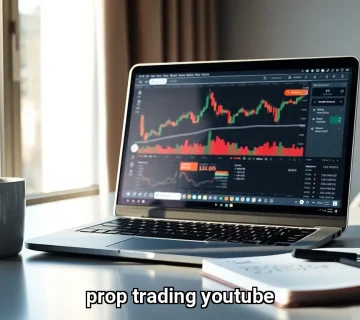Does prop trading still exist? Absolutely. Proprietary trading remains a viable and dynamic option in today’s fast-paced financial markets, even as the trading landscape continues to evolve. While some may argue that the rise of automated trading has overshadowed traditional methods, the truth is that prop trading has adapted to new technologies and regulatory changes, maintaining its relevance. The essence of prop trading lies in its ability to respond swiftly to market shifts, allowing firms to stay competitive in an ever-changing environment. By combining the analytical power of algorithms with the nuanced insights of human traders, proprietary trading continues to thrive as a flexible and innovative approach in modern finance.
In this article, we will explore the current state of prop trading, highlighting its significance in various sectors like hedge funds and independent trading firms. You’ll discover how firms are blending human intuition with advanced algorithms, creating a unique synergy that drives market success. The integration of these two elements not only enhances trading strategies but also ensures that firms can respond swiftly to market fluctuations. Furthermore, we will examine the promising future of prop trading, including emerging strategies and opportunities for traders looking to navigate this exciting field. The interplay between technology and human decision-making is setting the stage for a new era in trading, where adaptability and quick thinking are paramount.
Whether you’re curious about prop trading as a career path or considering it as an investment strategy, there’s plenty to uncover. Join us as we delve into the intricate world of proprietary trading and its relevance in the modern financial ecosystem. The insights you gain may just inspire your next trading move! Understanding the nuances of prop trading can empower you to make informed decisions, whether you are looking to join a firm or trade independently. The ongoing evolution of this sector signifies that there are numerous avenues for those willing to explore the depths of trading opportunities.

Does Prop Trading Still Exist?
Proprietary trading, commonly referred to as prop trading, continues to thrive, although its landscape has evolved significantly over the years. While some may argue that the rise of automated trading has diminished the need for human traders, the reality is that prop trading firms are still active across various sectors, including hedge funds, asset management companies, and independent trading firms. The existence of proprietary trading today is not merely an echo of the past; rather, it is a dynamic field that adapts to the changing financial environment. Prop trading firms leverage sophisticated algorithms and human intuition to navigate markets efficiently, creating a blend of technology and traditional trading practices that enhances their overall effectiveness.
In the current financial ecosystem, many prop trading firms have embraced automation, using advanced software to execute trades, analyze market data, and refine strategies. However, the role of human traders remains crucial in this equation. Human intuition is vital for tweaking algorithmic parameters, managing risk, and identifying emerging market opportunities that an algorithm may overlook. The distinction between “Trader” and “Developer” has become more pronounced, with specialized roles emerging in firms that utilize both human expertise and technological prowess. The collaboration between traders and developers fosters a culture of innovation and continuous improvement within prop trading firms. Thus, the answer to the question, “Does prop trading still exist?” is a resounding yes, although it functions differently than in the past.
The Future of Prop Trading
Looking ahead, the future of prop trading appears promising, especially as market conditions continue to evolve. The demand for innovative trading strategies and risk management techniques is higher than ever, providing ample opportunities for firms willing to adapt. Proprietary trading firms are increasingly focusing on diversification and multi-asset trading strategies, which can include everything from equities and options to cryptocurrencies and commodities. This diversification helps firms mitigate risk while maximizing potential returns, ensuring that they can weather market storms and capitalize on emerging trends.
Moreover, regulatory changes, such as the Volcker Rule, have reshaped the prop trading landscape. While the rule puts restrictions on large banks engaging in proprietary trading, it has led to the emergence of specialized firms that focus solely on prop trading. These firms can operate with more flexibility compared to traditional banks, allowing them to pursue aggressive trading strategies that may not be feasible within the confines of regulatory guidelines. The increased focus on compliance has pushed many traders to seek out firms like Propx Pro, which offer a more favorable trading environment, resources, and support for independent trading endeavors, fostering a more competitive environment in the industry.

Prop Trading in Today’s Market
In today’s market, proprietary trading remains a significant player, albeit under new guises. Traders are no longer confined to working with large banks; they have a plethora of options, including smaller independent firms and specialized prop trading shops. These firms often provide tailored solutions and trading environments that cater to individual trader preferences, allowing them to maximize their potential. For instance, Propx Pro, a reputable name in the industry, offers various challenge options and competitive spreads, making it easier for traders to find a platform that aligns with their trading styles and strategies.
Additionally, the integration of technology in prop trading has led to the rise of hybrid trading models. Many firms now operate on a tech-supported basis, where traders utilize advanced proprietary trading platforms that streamline operations and enhance decision-making processes. These platforms often come equipped with cutting-edge tools and analytics that provide traders with an edge in the fast-paced financial markets. As such, prop trading is not only surviving but thriving in the modern landscape, offering a plethora of opportunities for both seasoned traders and newcomers alike. The emphasis on technological integration signifies a shift toward a more data-driven approach to trading, where informed decisions can lead to enhanced profitability.
Understanding Prop Trading
To fully grasp the current state of prop trading, it is essential to understand its fundamental principles. Proprietary trading refers to financial firms or commercial banks investing their own capital to realize direct market gains, rather than earning commissions by trading on behalf of clients. This direct involvement allows firms to keep 100% of the profits generated from their trades, leading to potentially higher returns compared to traditional client-focused trading. The ability to leverage proprietary capital not only enhances ROI but also encourages firms to develop innovative strategies that can be tested and refined without the constraints of client mandates.
A variety of strategies are employed within prop trading, including index arbitrage, statistical arbitrage, and global macro trading, among others. These strategies enable traders to take advantage of price discrepancies and market inefficiencies. Moreover, proprietary trading desks typically operate independently from client-focused desks, ensuring that their trading activities do not conflict with the interests of clients. This separation is crucial for maintaining trust and ensuring compliance with regulatory standards, especially in light of past financial crises that revealed the dangers of conflated interests.

The Evolution of Proprietary Trading
The evolution of proprietary trading has been shaped by various factors, including technological advancements, regulatory changes, and shifting market dynamics. Historically, prop trading was synonymous with high-risk strategies and aggressive trading tactics, often leading to significant profits for firms. However, the landscape has changed dramatically since the 2007-2008 financial crisis, which prompted regulators to impose stricter rules on banks and financial institutions. The shift reflects a broader recognition of the need for stability and transparency in financial markets, influencing how firms approach trading.
The introduction of the Volcker Rule, aimed at curbing excessive risk-taking, effectively restricted banks from engaging in speculative proprietary trading. This shift resulted in many traders seeking opportunities outside traditional banking avenues, leading to the growth of independent prop trading firms. These firms, such as Propx Pro, have capitalized on the regulatory environment and the demand for specialized trading services, positioning themselves as viable alternatives for traders looking for more freedom and less oversight. The ongoing evolution of market regulations continues to influence the strategies and structures of prop trading firms, making adaptability a key attribute for success.
The Enduring Relevance of Proprietary Trading
In a world where the financial markets are constantly shifting, proprietary trading stands out as a resilient and evolving practice. This article illustrates that, contrary to perceptions of decline due to automation, prop trading is not only surviving but also thriving by integrating advanced technologies with human expertise. The unique synergy created by this blend equips traders to capitalize on market opportunities while effectively managing risks through innovative strategies. As technology continues to advance, the potential for prop trading firms to innovate and enhance their trading methodologies grows exponentially.
The emergence of specialized prop trading firms, like Propx Pro, showcases how the industry is adapting to regulatory changes and market demands, providing a fertile ground for both new and seasoned traders. As diversification and technological advancements continue to shape the future of trading, the potential for growth and success in proprietary trading becomes increasingly apparent. The commitment to continuous learning and adaptation will be essential as traders navigate an increasingly complex landscape.
Ultimately, the landscape of proprietary trading is vibrant and full of promise. By embracing both human intuition and state-of-the-art technology, traders can navigate the complexities of today’s financial markets with confidence. Whether you seek a career in prop trading or are considering it as part of your investment strategy, the opportunities are immense, and the journey is just beginning. So, to answer the question, “Does prop trading still exist?”—the resounding response is yes, and it is flourishing in exciting new forms. As the industry evolves, those who remain adaptable and proactive will undoubtedly find themselves at the forefront of this dynamic field.




No comment